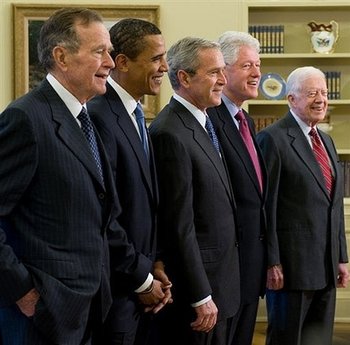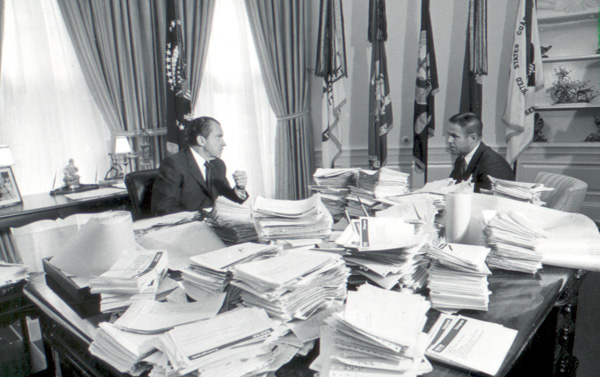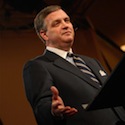
by Bret Capranica | Apr 1, 2011 | Featured Articles, Presidential History, Time/Life Management
Richard Nixon”™s approach to running the West Wing reshaped the role of the Chief of Staff to the point that it is still largely used to this day in the Office of the President. Interestingly, Eisenhower had a Chief of Staff, but most decisions were made by Cabinet Secretaries. Kennedy did not have a Chief of Staff and operated in a more free style with no intentional chain of command as to how decisions were made. Nixon changed the approach so that decisions were made in the White House and executed then by Cabinet Secretaries. He divided White House responsibilities into 3 areas: Domestic Council, National Security Council, and the Office of the President. Nixon wanted information mostly in written form and received it only from a few people with whom he would discuss it. They created the position of the Staff Secretariat who distributed the paper work appropriately. Trust was the most important commodity. Nixon was a very private person and preferred to consider succinct written proposals, summaries or analyses, with a few people. Decisions were made in the White House and Cabinet Secretaries executed those decisions. 7:30 a.m. was the start time for most White House senior officials. Nixon was careful with his public activities and focused on what would be the most significant issues. The president spent a tremendous amount of time on fewer things. Haldeman had a lack of ego, a passion for anonymity, but a self-confidence in his own ability. Trust and focus were his emphases. The story of the day, everyday, was “Think it Through!” Everything was thought through to the maximum. Every day at 2:00...

by Bret Capranica | Mar 29, 2011 | Featured Articles, Presidential History, Time/Life Management
Last year on President”™s Day, Kelly and I took a trip down to Yorba Linda and the Richard Nixon Library and Foundation. Admission was free, so we joined some 5,000 other people taking advantage of the opportunity. The highlight of the day was the panel lecture on “The Effective Use of the President”™s Time.” The panel was made up of four men who served in the West Wing of the White House and, more specifically, worked directly under H. R. “Bob” Haldeman, Nixon”™s Chief of Staff. They discussed the climate of which Nixon assumed the presidency, how foreign trips were staffed, and most importantly, how they helped the President make the best use of his time. Nixon”™s end is usually where we begin in thinking about his time in office and tends to dominate the flavor of the entirety of his presidency. That is unfortunate. Many, initiatives, policies, and governmental advancements that remain in place today were initiated during his years in the White House. In fact, the entire structure of the modern day Office of the President was essentially created during his tenure and remains in tact today. The lecture was a fascinating look into the Presidency. Today and Friday I”™ll post my bulleted notes from the lecture. On Saturday, I”™ll give a few thoughts on how these themes could bring helpful consideration to an ordinary pastor”™s ministry. Nixon was friendly, but we were not friends. Nixon lost the 1960 election because he tried to run the campaign himself. In 1968 (the year he won the Presidency), he put key managers in every position. Haldeman issued a memo in the 1968...

by Bret Capranica | Feb 28, 2011 | Featured Articles, Ordinary Pastor, Pastoral Ministry, Presidential History, Technology
Regardless of what you think of our President’s policies, Barak Obama‘s team is doing an excellent job in its use of media, particularly social media. Technology is enhancing how we communicate our messages and priorities, and the Obama White House has a firm handle on how to do it well. From the first days after his election and as the President-elect, Barak Obama began weekly video addresses (in addition to the old-guard radio address), and a series of video posts from various internal groups working on policy issues. They are always enhancing how they use media to connect with people. Media tends to connect people in a more personal way and not merely in a starched policy manner. In fact, one of the ways the White House is utilizing media well, is to bring the public inside the secured walls of the White House and show them how people and the process work. An excellent illustration of this was the 2011 State of the Union. In addition to a brief video on how the speech was constructed, the White House, for the first time, included enhanced on-line media (like a power-point presentation), chats, use of Twitter, and live online interviews with the President after the speech. I’ve seen few public sector organizations work this well on connecting people more personally. State of the Union Video There is much modern church ministry can learn from the rapid growth of technology. While the message is most important and should be the laser-like focus of leaders and members alike, technology has provided unprecedented ways to publicly broadcast our message. From the use of Twitter and Facebook to quickly inform...

by Bret Capranica | Jan 16, 2011 | Culture, General Theology
For further reading and more extensive information from tonight’s message on the biblical response to homosexuality, I found the The Fall 2008 issue of The Master’s Seminary Journal helpful. I’ve linked to the pdf copies: “God’s Word on Homosexuality: The Truth about Sin and the reality of Forgiveness,” John MacArthur “Cultural and Medical Myths about Homosexuality,” Michael A. Grisaniti “Marriage and Homosexuality: Toward a Biblical Understanding,” Irvan A. Busenitz “Parenting and Homosexuality,” Richard L. Holland “The Church’s Response to Homosexuality,” Alex D. Montoya Also, much of the material in my message on the biblical term used in the NT for “homosexuality” can be found in the following article: “The Source and NT Meaning of APZENDOKOITAI with Implications for Christian Ethics and Ministry,” James B....

by Bret Capranica | Jul 1, 2010 | Culture, Science, The Gospel
I was privileged to meet Dr. Andy Davis this past April. Aside from his obvious brilliance, he has memorized vast portions of Scripture and is so amazingly and encouragingly insightful in his understanding of God’s Word. Here is Dr. Davis, an MIT grad, discussing the question, has science buried God? [You Tube Video] HT: Thabiti...

by Bret Capranica | Mar 29, 2010 | Culture
Watch this video to the end: HT: Denny...













